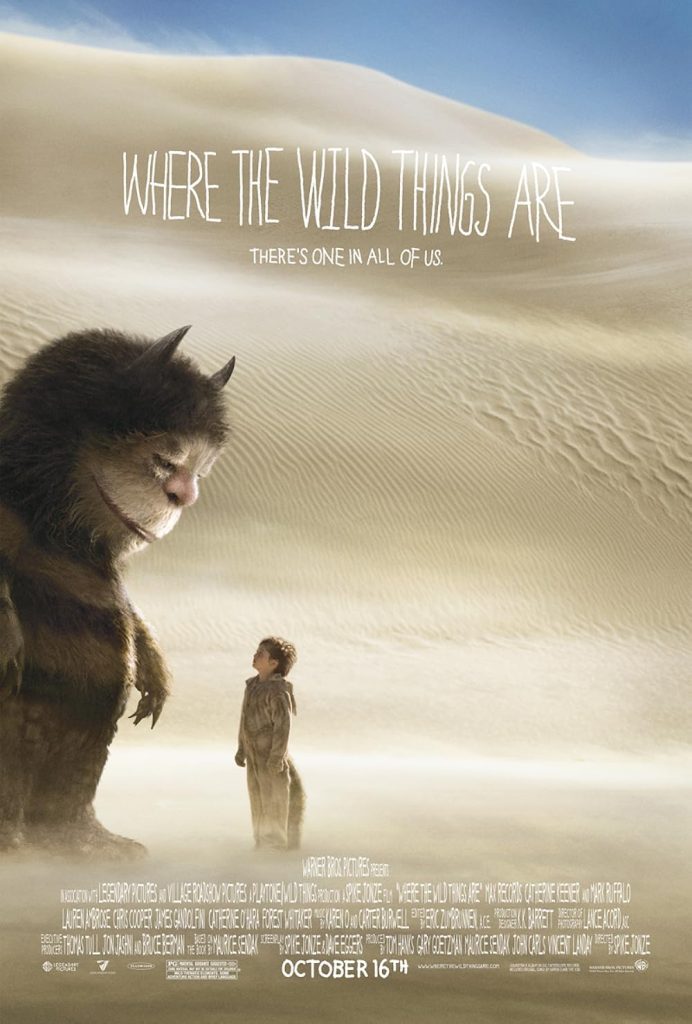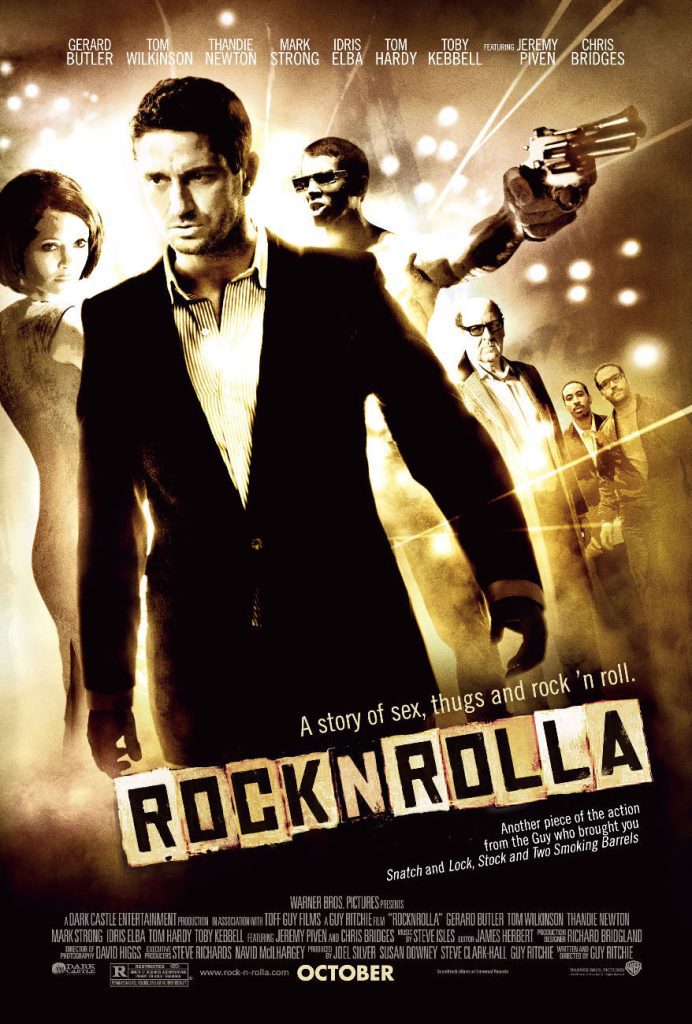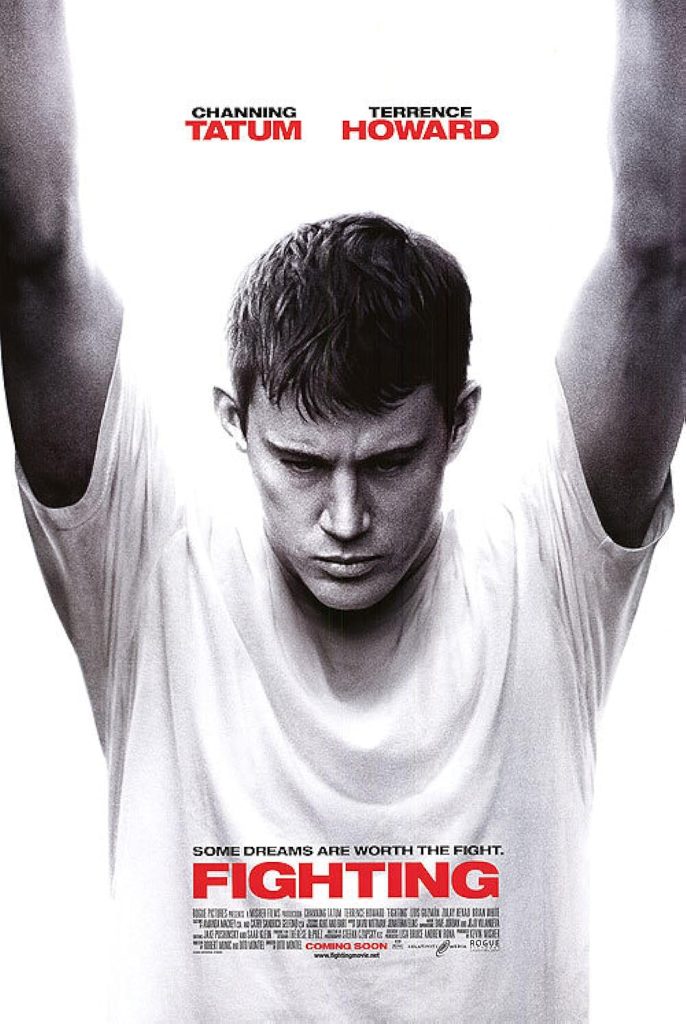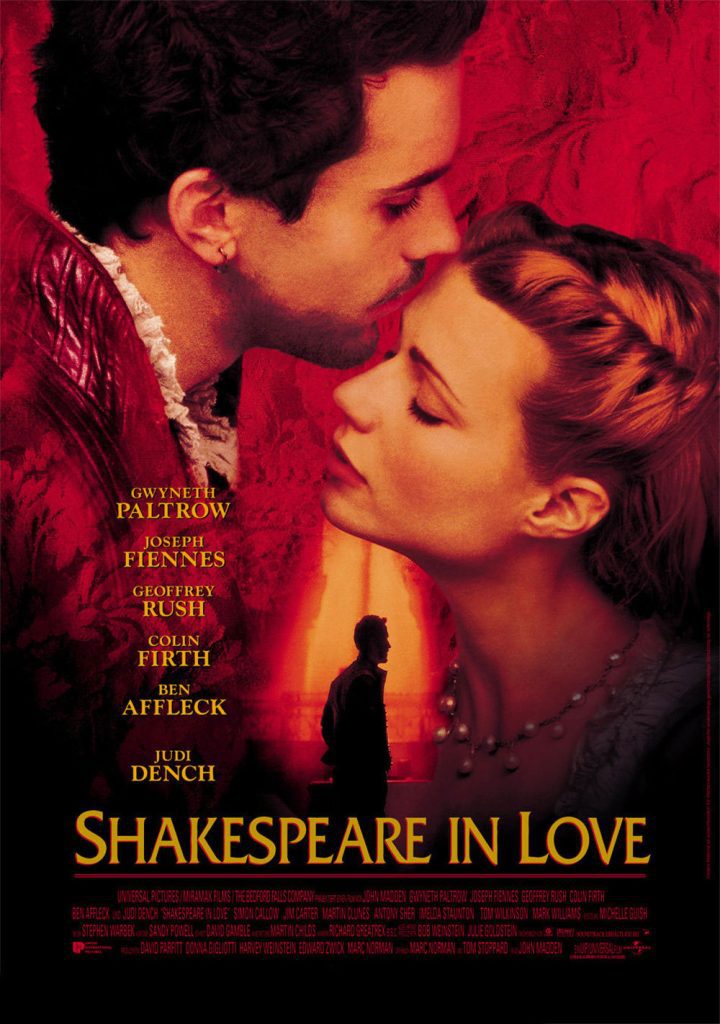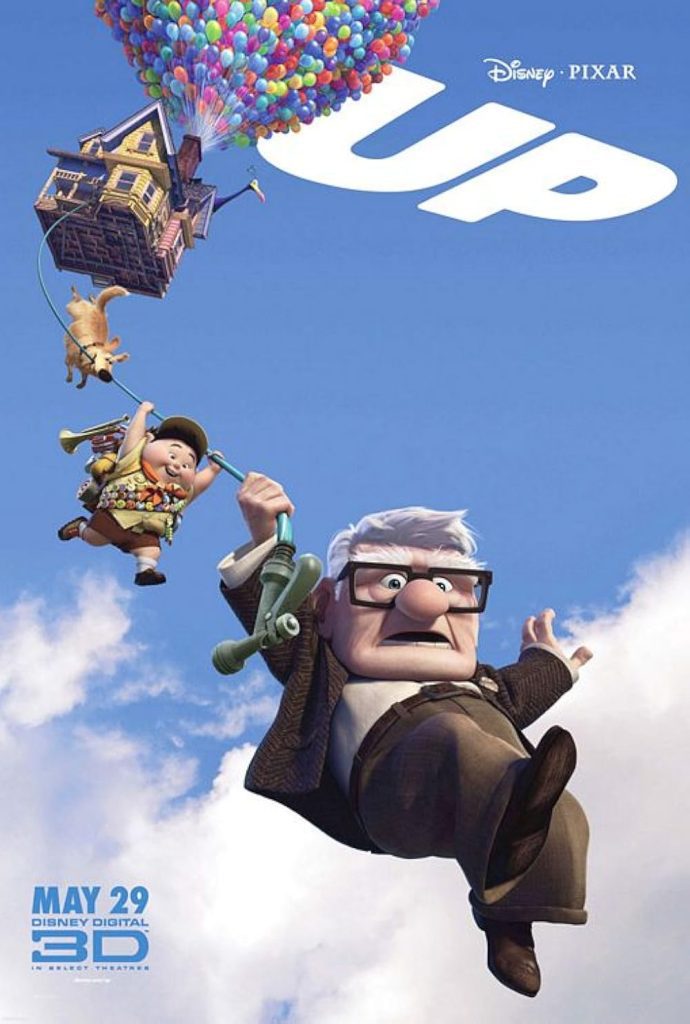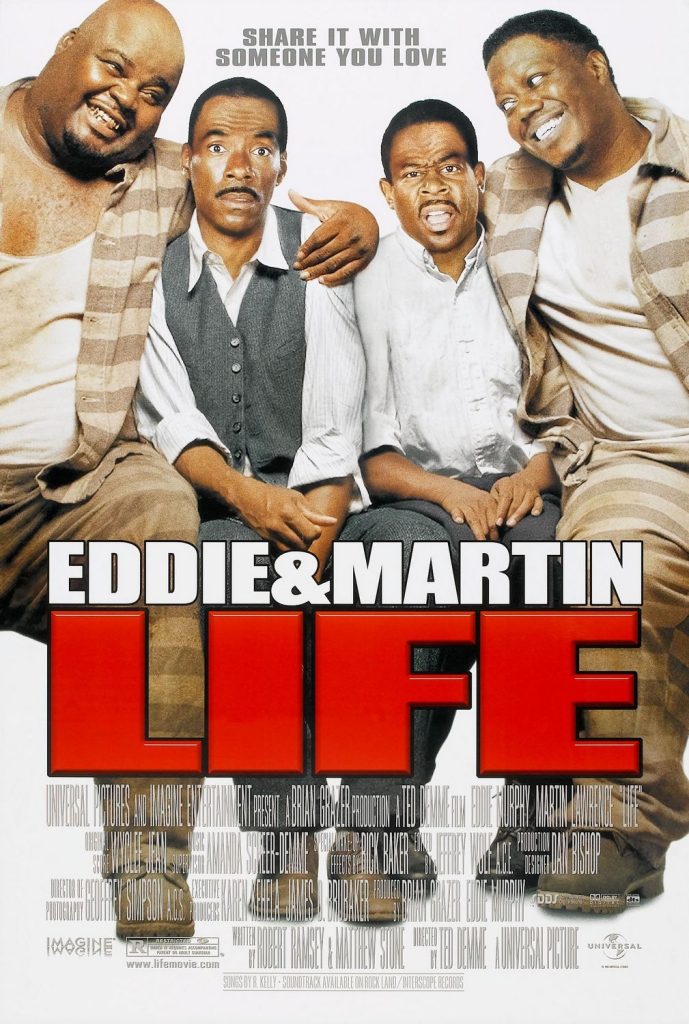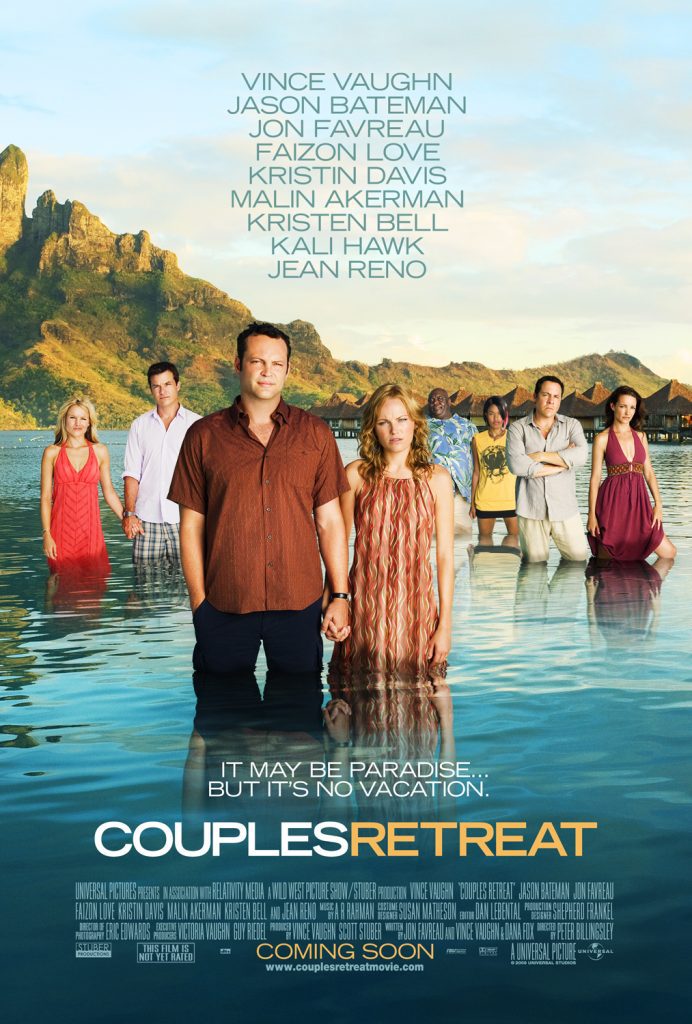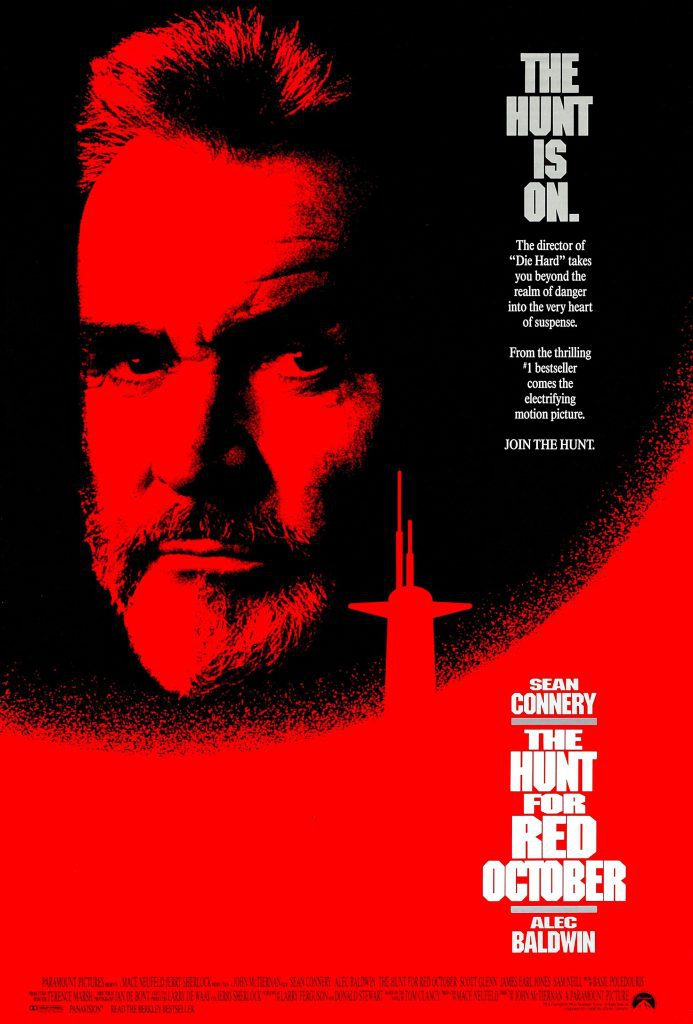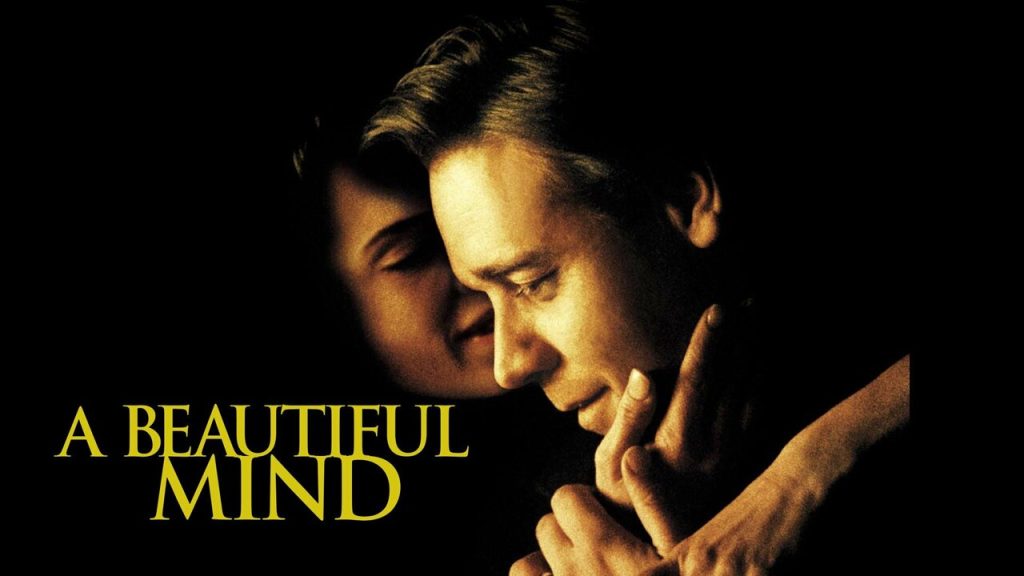
A Beautiful Mind is based on the life of John Nash, a Nobel Prize winning mathematician who battled with the debilitating mental illness schizophrenia. It features great performances from its three leads, capable direction, and a script…well, let’s just talk about that later, shall we?
John Nash (Russell Crowe) has a beautiful mind. The title of the movie tells us that. But, you wouldn’t know by looking, because he’s an abrasive, arrogant, off-kilter man trying to make his idiosyncratic way in academia. He’s convinced he can find an “original idea,” something that will set him apart from his peers. And he does, writing a thesis that will unseat years of economic thought and become the basis for capitalism of the late 20th century. Forty or so years later, he wins a Nobel Prize for his work.
Another movie, perhaps starring Robin Williams, might be content to stop there. But no, that’s only the first half-hour.
John moves on from his distinguished career as a student to working for a government think tank in a university. He’s required to teach a class, even though his caustic personality makes him ill-suited to the task. There he meets his future wife, Alicia (Jennifer Connelly), and is approached by an enigmatic government agent, Parcher (Ed Harris), to help break codes for the CIA.
I feel I’m a bit in the dark approaching this film. I have not read the book upon which A Beautiful Mind is based. My knowledge of the real John Nash is only what I gleaned from the entertainment media and the controversy surrounding this film. My mathematics abilities are limited to an introductory statistics course. What I know about mental health could fill a slim volume entitled “Everything I Know About Schizophrenia I Learned From What About Bob?” I was very harsh toward the film after it won several Academy Awards earlier this year because its screenwriter is responsible for some of the most wretched examples of modern Hollywood moviemaking I’ve had the displeasure to see. And yet, by some wicked twist of fate, the studio sent the screener to me rather than our regular screener distribution person. I was prepared to hate it, because I had seen or heard nothing that would give me any other premonition. And you know what? It wasn’t as bad as I thought.
I’m going to declare that there’s three assumptions a filmmaker cannot make when making a movie. When it comes to A Beautiful Mind, as they say, two out of three ain’t bad. One, you can’t assume that the audience is going to have advance knowledge of the topic the person upon which the film is based, the complex themes, the extraneous details of the book that were left out of the film, anything. A Beautiful Mind gets that right. I’m sure it would help to know more details about paranoid schizophrenia to know if it’s an accurate portrayal of the condition, or more about game theory to see if the limited details are correct, or more about the life of John Nash to see how much creative license they took (which was considerable, if you believe the hoopla), but the movie is self-contained enough to take it on its own terms. Two, you can’t assume that the audience is stupid. A Beautiful Mind succeeds in that regard, mostly. The complex subjects of mathematics, cryptography, and mental health are reduced to terms even a third grader would understand, yet you never get the sense that the film is talking down to you. Three, you can’t assume that good actors will elevate material that’s…fill in the blank with your favorite from the following list: inadequate, deficient, lame. Herein lies the reason A Beautiful Mind is merely an okay movie instead of a truly excellent one.
There’s this reoccurring bit that David Letterman does on his show. Two guys, regular Joe Sixpacks, read transcripts from Oprah Winfrey. When they read it, it’s wickedly funny because their sloppy appearance and gruff demeanors clash with the sappy material. That’s what I thought of while watching Crowe, Connelly, and Harris work with admirable earnestness with Akiva Goldsman’s feeble screenplay.
Dear readers, if there is one screenwriter in Hollywood that I despise, it is Akiva Goldsman. This animosity goes back to 1994, when I wasted good money to see Silent Fall, his poor excuse for a thriller starring Richard Dreyfuss and Linda Hamilton, and featuring the screen debut of everyone’s favorite ingénue, Liv Tyler. His John Grisham adaptations, The Client and A Time To Kill, were blandly inoffensive, but a war crime tribunal is in order for the vileness that were Batman Forever, Batman and Robin, and Lost In Space. It was the latter film that finally made me get wise to the error of seeing anything with the name Akiva Goldsman listed as a writer. (Producer, on the other hand, is another matter I love Deep Blue Sea more than a self-respecting professional film critic should.) A Beautiful Mind goes a long way toward redeeming his wretched name, but not nearly far enough. How this screenplay could win an Oscar is beyond me, especially when its competition included the insightful Ghost World. It’s as basic as the work of someone who just finished reading a Lew Hunter writing guide. Exposition is painfully forced into conversations (particularly in the first few scenes of the film), and it relies too often on title cards flashing up to announce the passage of time. Most egregious of all, the dialogue is just that: dialogue, sounding stilted and forced and on occasion groan-inducing. I love stylized movie dialogue as much as the next David Mamet or Quentin Tarantino devotee. There’s a difference, because that dialogue defines the characters and the particular idiom of a film made by those writer/directors. This dialogue is just…blah. “Perhaps it is good to have a beautiful mind, but an even greater gift is to discover a beautiful heart”? Ugh!
Despite the failings of the material, it’s the work of the principal trio that makes the film watchable and worth watching. Russell Crowe has been a favorite of mine since his earliest Hollywood films, The Quick and the Dead and Virtuosity (both highly underrated and overlooked movies). He deserved a Best Supporting Actor Oscar nomination for L.A. Confidential, much more so than Greg Kinnear for his tepid role in As Good As It Gets or Robin Williams (who won the award) for Good Will Hunting. It took Gladiator to make him a star when any of his other films would’ve better demonstrated his talent. A Beautiful Mind is both served and disserved by his talents. On one hand, he has that character actor ability to get lost in his roles, and for 134 minutes he is John Nash. He affects the mannerisms of a genius/madman with remarkable skill. However, he is now in the ranks of the über-stars, and you can’t escape thinking that John Nash in no way looked like this chiseled hunk who appears to have just stepped off the set of Gladiator. You’d think that the guy who packed on the pounds for The Insider could become a gaunt nerd for this role, but nope, here Nash is a burly Aussie. Jennifer Connelly continues her string of great performances. She’s such a fascinating mix of beauty, brains, class, warmth, and reserve. (Yes, I know that “warmth” and “reserve” seem like polar opposites. That’s part of what makes her fascinating.) She’s burdened with some of the worst dialogue in the film particularly grating is the scene when she tells John that she won’t put him in an asylum but she manages to make her scenes work. At the end of the film, I wished I had seen more of her than the thankless part she was given. It’s a testament to her abilities that the Academy saw something in her performance. Ed Harris is also one of my favorite actors, always believable in his roles. I particularly liked him in The Rock. He has the same sort of steely militaristic demeanor here, but without a script with uncredited rewrites by Quentin Tarantino and Aaron Sorkin to make him sound like a bad-ass.
And what of Ron Howard’s direction? Like the rest of his films, it lacks any characteristic style. He’s amorphous to the material, which in ways is good, but in other ways makes him indistinguishable from any number of other capable directors. Don’t get me wrong, he knows the directing craft, and he makes quality films and A Beautiful Mind is certainly a quality film, screenplay notwithstanding but there’s nothing here that says “Ron Howard directed this movie” instead of Frank Darabont, or Bruce Beresford, or Robert Zemeckis. There’s nothing flashy or quirky about his camera usage, not that this material would benefit from such. He does employ some subtle and creative digital effects, one of which I won’t reveal but that had me slapping my head while watching the special features that I didn’t notice it. Okay, here’s a clue: watch the pigeons.
And what of the disc? The film is anamorphically presented in its theatrical 1.85:1 aspect, and the transfer is very pleasing. Colors are beautifully rendered, with nice shadow detail, no apparent pixelation, and a respectful average bitrate (6.51 Mbps, pushing it into “Superbit” territory). I noticed some not overly obtrusive edge enhancement at times, so if I noticed it with a 27″ television, those of you with larger displays might find it more distracting than I did. The Dolby Digital 5.1 gives you everything you would expect from a drama primarily front-loaded and dialogue-heavy but the track is remarkably lush and rich-sounding, giving great presence to James Horner’s score. There’s even a few key scenes that use the surrounds and LFE to good effect.
A Beautiful Mind is a two disc set, so what about the special features? On the first disc, you get two commentary tracks, plus deleted scenes and DVD-ROM goodies. Director Ron Howard and writer Akiva Goldsman are both afforded their own commentaries. I really enjoyed Howard’s comments; though I wasn’t that keen on the film, his comments made me look at it in a better light. He is rarely silent, always giving anecdotes or insights into the hows and whys of certain scenes or conventions used in the film. Example: Howard shares that most schizophrenic delusions are aurally based people more often hear things than they see things so they chose to introduce all the delusional characters in the film by letting us hear them first. It’s subtle, and it works. Akiva Goldsman…well, you can already guess that I didn’t care for his track much. I was prepared to give him a chance, but that was shattered in the first minute of the film. See, it starts out with agonizingly slow production company credits three of them, all displayed for at least 20 or 30 seconds. After he introduces himself, here’s a transcript of his insights: “This is the Universal logo. A great logo. It looks like the entire world has been irradiated…This is the DreamWorks logo. There’s a little boy fishing off a letter…This is the Imagine logo. I don’t have anything funny to say about the Imagine logo.” Even though it’s now at Mole People depths, it all kinda goes downhill from there.
There’s about 27 minutes of deleted scenes, with optional commentary by Ron Howard. Like most deleted scene reels, it’s a mixed bag of the “gee, I wish they’d left that in” and “gee, I’m glad they left that out.” There’s a few scenes of his studies at Princeton that would have been interesting and would have better established his eccentricity and brilliance, particularly his obsession with creating a better version of the game Go (which is based on something he really did he changed the board and the rules so that the game would be based more on skill than chance). An extended ending to the movie’s chase scene would have more firmly established the payoff later when you discover that Nash is delusional, and an extra scene in the mental asylum between Crowe and Christopher Plummer (playing a psychiatrist) is acting gold. However, another scene at the party early in John and Alicia’s relationship is painful to watch and is better left excised (it’s straight out of a Meg Ryan movie, and it would’ve been completely out of place), and the scenes showing Alicia slowly unraveling her husband’s hallucinations are redundant.
Moving on to the second disc, let’s go through the features in order:
- A Beautiful Partnership: Ron Howard and Brian Grazer: This five-minute piece is the aforementioned guys talking about their involvement in the movie. It’s mostly brown-nosing fluff with little substance.
- Development of the Screenplay: More brown-nosing, this time eight minutes of everyone ignoring that Akiva Goldsman wrote Batman and Robin. Okay, it’s more than that. Goldsman talks about getting the project, his writing process, and his favorite scenes in the film.
- Meeting John Nash: Here you get eight minutes with the real John Nash. The disc needed more of this sort of material. He explains his game theory, which may cause your eyes to glaze over if thinking about things other than your grocery list causes boredom.
- Accepting the Nobel Prize in Economics: Two minutes of video from the Nobel ceremony presenting Nash with his prize.
- Casting Russell Crowe and Jennifer Connelly: Six minutes of Ron Howard and Brian Grazer talking about why they wanted these two fine actors for their film. They spend most of their time talking about Russell Crowe, and even when they do talk about Jennifer Connelly, it’s kind of in a backhanded way, as if she worked well with Crowe so that’s why she got the role. Who won the Oscar here, guys?
- The Process of Age Progression: Seven minutes about the makeup. It’s not exciting stuff, but very informative.
- Storyboard Comparisons: Ron Howard gives a half-minute introduction to the use of storyboards, followed by five scenes viewable either split-screen (final film and storyboard) or just as a storyboard.
- Creation of the Special Effects: This is the best of the featurettes. It’s 11 minutes of Digital Domain techs talking about the digital magic that went into the movie. They take several scenes and show you the entire process that went from on-set shooting to final product, highlighting every step along the way. It’s the best breakdown of CG I’ve seen since The Phantom Menace.
- Scoring the Film: Six minutes on James Horner. He’s not one of my favorite film composers, but his score here fits quite well.
- Inside A Beautiful Mind: This is your conventional promotional featurette. It runs 23 minutes and is your usual mix of clips and talking heads. At least here one of the talking heads is John Nash.
- Academy Awards: Here you get to see A Beautiful Mind winning its four Oscars. Well, you only get to see one clip from the ceremony proper; the rest is backstage interviews.
- Theatrical Trailer: Like it says. It’s presented in non-anamorphic widescreen.
- A Beautiful Mind Soundtrack: 30 seconds promoting the score CD.
- Now Showing: You might think this is for theatrical releases, but nope, it’s for DVDs like Apollo 13, The Family Man, K-PAX, and Patch Adams.
- Organizations: Web links to mental health organizations.
I have a few pet peeves about the disc. Despite having no DTS track to bugger things up, Universal insists on forcing you to return to the menus to switch audio tracks. I wish studios would use something other than the InterActual PCFriendly software to power the DVD-ROM side of their discs. I didn’t want to install their software again, subjecting my computer to their invasive “registration” routine, just to get a few weblinks. (And I’d like to see DVD File say something like that in their review!) The cover art shows again what little regard the filmmakers had for the talented, Oscar-winning Jennifer Connelly. Nearly as big as the title, you get Russell Crowe’s name. You get the “A Ron Howard Film” tag. You even get Ed Harris’ name, off to the side and a bit smaller. But is Jennifer Connelly mentioned? Nope. To remind you what a great film it is, the on-disc art on both discs features quotes from critics (if you can still call Gene Shalit a film critic) saying what a wonderful movie it is.
Prior to watching this disc, I wouldn’t have figured I’d be recommending A Beautiful Mind.
A Beautiful Mind is far from perfect, and I can name at least five or six movies from 2001 I’d preferred to have won Best Picture, but it’s worth seeing for its fine acting and its accurate and balanced portrayal of schizophrenia. Universal/DreamWorks has issued a disc with great technical merits and over an hour’s worth of solid content. Definitely give it a rental.
For more movies visit Soap2day.
